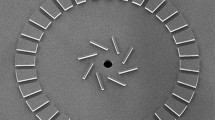Abstract
This paper describes the microfocusing in a microchannel using the thermal actuation of a pair of microbubbles. A microbubble was produced from de-ionized (DI) water with an integrated microheater, and the volume was controlled by applying voltage. The microfocusing was demonstrated with a polydimethylsiloxane (PDMS) device consisting of two layers. The top layer included a microchannel that was 300 μm wide and 50 μm high. It was flanked by a pair of reservoirs. The bottom layer provided a microheater underneath the reservoir. Upon heating, DI water boiled immediately over the microheater and formed a microbubble that came out of the reservoir in a perpendicular direction toward the fluid. The fluid was focused from 300 to 22 μm, as the distance between the apexes of the arch-shaped microbubbles was shortened due to expansion, which was maintained at a flow velocity up to approximately 17.8 mm s−1. The temperature of the water in the reservoir was estimated to reach the boiling point within 62 or 160 ms, depending on the substrate.









Similar content being viewed by others
References
Cho SK, Moon HJ, Kim CJ (2003) Creating, transporting, cutting, and merging liquid droplets by electrowetting-based actuation for digital microfluidic circuits. J Microelectromech Syst 12:70–80
Barz DPJ, Ehrhard P (2005) Model and verification of electrokinetic flow and transport in a micro-electrophoresis device. Lab Chip 5:949–958
Dittrich PS, Schwille P (2003) An integrated microfluidic system for reaction, high-sensitivity detection, and sorting of fluorescent cells and particles. Anal Chem 75:5767–5774
Knight JB, Vishwanath A, Brody JP, Austin RH (1998) Hydrodynamic focusing on a silicon chip: Mixing nanoliters in microseconds. Phys Rev Lett 80:3863–3866
Kruger J, Singh K, O’Neill A, Jackson C, Morrison A, O’Brien P (2002) Development of a microfluidic device for fluorescence activated cell sorting. J Micromech Microeng 12:486–494
Lee GB, Hwei BH, Huang GR (2001) Micromachined pre-focused M × N flow switches for continuous multi-sample injection. J Micromech Microeng 11:654–661
Li HB, Zheng YN, Akin D, Bashir R (2005) Characterization and modeling of a microfluidic dielectrophoresis filter for biological species. J Microelectromech Syst 14:103–112
Liu RH, Yang JN, Pindera MZ, Athavale M, Grodzinski P (2002) Bubble-induced acoustic micromixing. Lab Chip 2:151–157
Lu H, Gaudet S, Schmidt MA, Jensen KF (2004) A microfabricated device for subcellular organelle sorting. Anal Chem 76:5705–5712
Munson MS, Hawkins KR, Hasenbank MS, Yager P (2005) Diffusion based analysis in a sheath flow microchannel: the sheath flow T-sensor. Lab Chip 5:856–862
Razunguzwa TT, Lenke J, Timperman AT (2005) An electrokinetic/hydrodynamic flow microfluidic CE-ESI-MS interface utilizing a hydrodynamic flow restrictor for delivery of samples under low EOF conditions. Lab Chip 5:851–855
Ren CL, Li DQ (2006) Electrokinetic sample transport in a microchannel with spatial electrical conductivity gradients. J Colloid Interface Sci 294:482–491
Reynard C, Barthes M, Santini R, Tadrist L (2005) Experimental study of the onset of the 3D oscillatory thermocapillary convection around a single air or vapor bubble. Influence on heat transfer. Exp Therm Fluid Sci 29:783–793
Schnelle T, Muller T, Gradl G, Shirley SG, Fuhr G (1999) Paired microelectrode system: dielectrophoretic particle sorting and force calibration. J Electrostat 47:121–132
Tokimoto T, Tsukahara S, Watarai H (2005) Lactone cleavage reaction kinetics of rhodamine dye at liquid/liquid interfaces studied by micro-two-phase sheath flow two-photon excitation fluorescence microscopy. Langmuir 21:1299–1304
Tsai JH, Lin LW (2002) A thermal-bubble-actuated micronozzle-diffuser pump. J Microelectromech Syst 11:665–671
Vestad T, Marr DWM, Oakey J (2004) Flow control for capillary-pumped microfluidic systems. J Micromech Microeng 14:1503–1506
Wang XB, Huang Y, Gascoyne PRC, Becker FF (1997) Dielectrophoretic manipulation of particles. IEEE Trans Ind Appl Soc 33:660–669
Washizu M (2005) Biological applications of electrostatic surface field effects. J Electrostat 63:795–802
Yang JT, Huang KJ, Lin YC (2005) Geometric effects on fluid mixing in passive grooved micromixers. Lab Chip 5:1140–1147
Yao B, Luo GA, Feng X, Wang W, Chen LX, Wang YM (2004) A microfluidic device based on gravity and electric force driving for flow cytometry and fluorescence activated cell sorting. Lab Chip 4:603–607
Yaralioglu GG, Wygant IO, Marentis TC, Khuri-Yakub BT (2004) Ultrasonic mixing in microfluidic channels using integrated transducers. Anal Chem 76:3694–3698
Yin ZZ, Prosperetti A (2005) ‘Blinking bubble’ micropump with microfabricated heaters. J Micromech Microeng 15:1683–1691
Acknowledgments
This study was supported by a grant (02-K14–01-005-1-2) from the Center for Nanoscale Mechatronics & Manufacturing, one of 21st Century Frontier Research Programs, Ministry of Science and Technology, Republic of Korea.
Author information
Authors and Affiliations
Corresponding author
Rights and permissions
About this article
Cite this article
Son, S.U., Lee, S.S. Microfocusing using the thermal actuation of microbubbles. Microfluid Nanofluid 6, 77–84 (2009). https://doi.org/10.1007/s10404-008-0297-1
Received:
Accepted:
Published:
Issue Date:
DOI: https://doi.org/10.1007/s10404-008-0297-1




